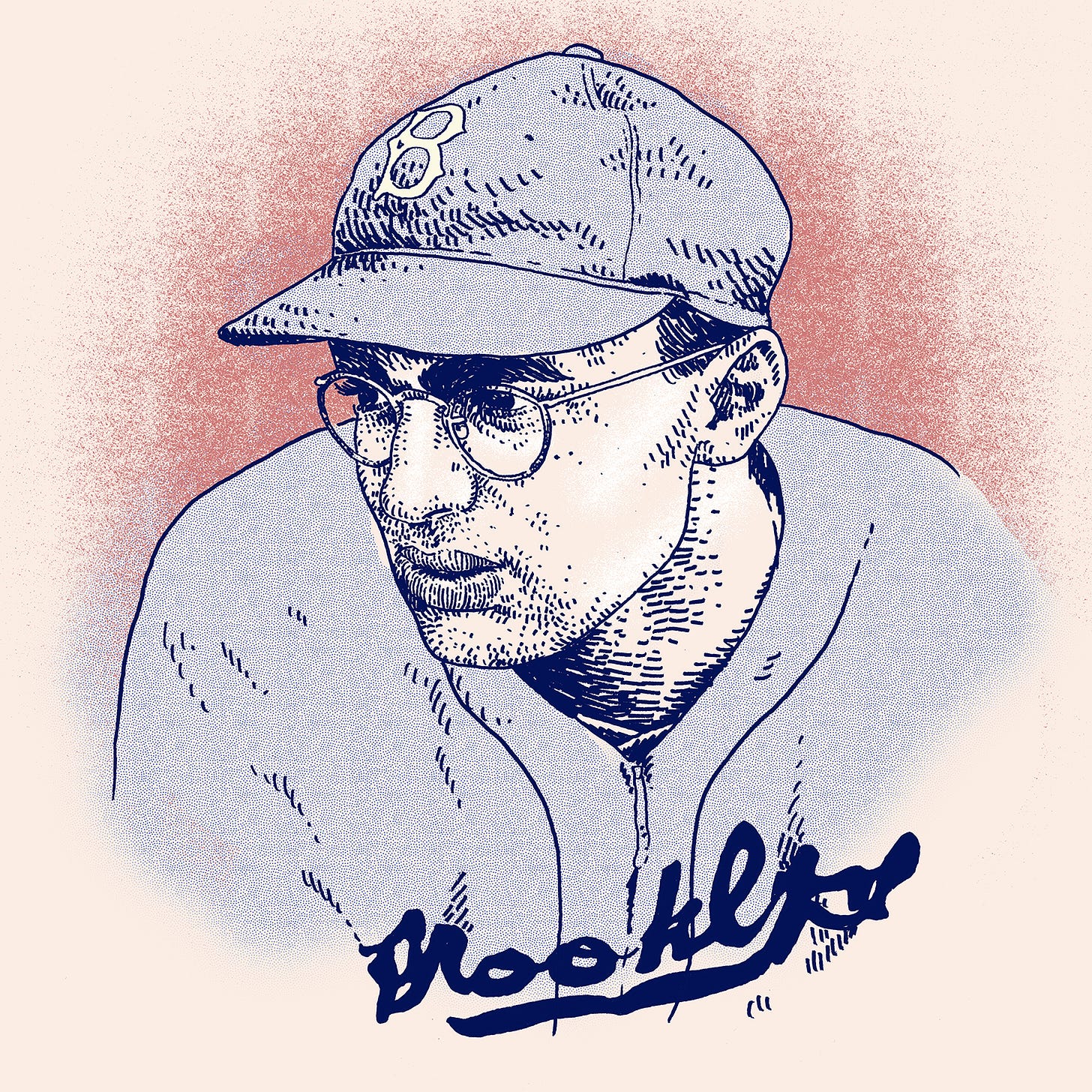The Pitcher was a Communist
Sam Nahem was a Dodger, a Phillie, a Cardinal...and the other kind of Red
The first thing Adam and I ever collaborated on unbound by the chains of corporate America were a couple of baseball zines called Notable Ballplayers. They were really simple: paragraph length biographies of the baseball players beside their portraits. I wrote the paragraphs, and Adam drew the portraits. The first volume consisted of players who died during their careers. The second was of Dodger Rookie of the Year winners. We’re hoping to get to a third volume at some point.
Sports Stories is not exactly a direct descendant of the zines, but it would be fair to say that had we not done them we would not have started this newsletter. The spirit of Sports Stories is the spirit of Notable Ballplayers, more or less. And this week’s subject is just such a deeply notable ballplayer that it would have felt wrong to feature him without mentioning the zines first.
This is a player who until fairly recently, we had never heard of. He was unremarkable as a major league pitcher. But he was also quite remarkable. He lived one of those beautiful weird rich lives that seem like they can only have taken place in the distant past. But honestly, it wasn’t even that distant.

Sam Nahem’s parents immigrated to Brooklyn from Aleppo, Syria in 1912. Sam was born three years later. The Nahems were a big family, and they were part of a tight knit community of Syrian Jews. Sam’s first language was Arabic. His childhood was like one of those picaresque novels, or a flashback sequence of old timey Brooklyn. He picked up English. He learned to play sports. His older siblings and cousins taught him about life. When he was 12, his father died when a steamship he was traveling on sank in the Atlantic. The family sued the steamship company and won enough money to live out the Depression in relative comfort.
(If it feels like I’m just reciting facts it’s because there are so many details in Sam Nahem’s life that it would feel unfair to leave any out. But I’m going to start leaving some out. So if you want the full, richly researched and footnoted version of his life, you should just head over now to read Peter Dreier’s biography of Nahem for SABR. )
The teenage Nahem becomes a star athlete, quits going to synagogue after his Bar Mitzvah, and is indoctrinated by his cool older cousins into radical politics. Typical American story right? He is both one of Brooklyn’s most beloved high school jocks, and one of its most committed young activists. He is big and burly. He reads poetry. He can make a baseball do anything he wants. He wears glasses on the mound.
Nahem went to Brooklyn College, where his politics became even more radical. (He became a member of the Communist Party, and also was signed by the Brooklyn Dodgers, his hometown team. Nahem quit school to go play minor league ball with the Dodgers. In the offseasons, he went and got his law degree. This brings us to 1938, the year Nahem made his major league debut with Brooklyn, late in the season with nothing on the line. He tossed a complete game victory in Philadelphia. The season ended. And Sam Nahem didn’t sniff the big leagues for another three years.
During his minor league sojourn, Nahem was an even odder duck. Just the fact of an actual New Yorker on one of these teams was remarkable. Nahem’s nickname was literally Subway Sam. But a Jewish intellectual from Brooklyn playing ball in what often were segregated white southern towns was practically inconceivable. Nahem didn’t tell people he was a Communist Party member (that would have been career suicide in baseball, and was in fact a closely held secret), but he did try to talk his fellow players into more progressive perspectives on subjects like baseball’s color line. During Sam’s career, the Communist Party was actually one of the organizations pushing hardest for baseball to integrate.

Later, Nahem wrote in an unpublished memoir recovered by Dreier that he believed most white players opposed baseball’s integration not for racial reasons, but for economic ones: they didn’t want to lose their jobs. Nahem was much more interested in doing the right thing than in keeping his job -- and to be honest, his case for a major league roster spot was thin anyway.
He pitched in 1941 and 1942 for the Cardinals and Phillies respectively. Then he went to the Army, where first in upstate New York and later in France, he organized baseball clubs. Nahem’s teams were dominant, and they were unique in that he insisted on integrating them with Negro League stars. One of his teams even won a series playing on the Nazi party rallying grounds in Nuremberg.
Imagine: just a dozen years after Hitler’s famous rally of 1933, a Syrian-American Jewish Communist baseball player leading an integrated club to a spectacular triumph in that very place.

After the war, Nahem retired from pro ball. He pitched for a semi-pro team called the Brooklyn Bushwicks and practiced law. In the offseason, he would go down to Venezuela and Puerto Rico to play winter ball. He remained an activist, and even floated a few runs for office in New York. Then in 1948, he was recruited to return to the Phillies. It didn’t go well -- Nahem pitched poorly and was hated by his manager, the famous racist Ben Chapman.
Chapman was so racist he became the villain in the Hollywood adaptation of Jackie Robinson’s life. Nahem on the other hand once threw a high and inside pitch to Roy Campanella and felt guilty about it for years.
After baseball, Nahem gave up on the law, and finally gave up on New York. Eventually, he also gave up on the Communist Party. (Like many party members, he grew disenchanted with the Soviet Union’s militarism.) He moved with his family to the Bay Area and went to work in a fertilizer plant, where he was a union leader and organizer. Sam Nahem died in 2004 at 88 years old. He was a notable ballplayer.
Related Reading
The two best articles on Sam Nahem (in my opinion) are written by the same person. I don’t know why Peter Dreier hasn’t written a book on Nahem yet. But I think he should. You should read both Dreier’s biography of Nahem for SABR, and OUT OF LEFT FIELD, an expansive story Dreier co-wrote with Robert Elias for Jacobin Magazine about radicals in baseball. The Jacobin story does a really nice job of putting Nahem’s career into context.
You can look at baseball history as a century and a half of owners suppressing labor for the sake of their pocketbooks, and labor slowly gaining a foothold as the game became increasingly commercial. Or you can look at it as a game that has always made room for weirdo radicals like Sam Nahem, and has allowed itself to be pushed by those radicals to a more inclusive, egalitarian identity. Or you can look at baseball as just a sport, just another thing, just another part of America where there is room for Ben Chapmans and Sam Nahems, and there always will be.
Also: if we’re talking Sam Nahem, we should also discuss the pitcher who was his opposite: no, not Curt Schilling, but Eric Show. This is a good read by Bryan Curtis of The Ringer on the former pitcher and his crew of fellow John Birch Society members.
Book Stuff
We’re still sending out Adam’s beautiful cards to folks who pre-order STEALING HOME.


Get yours and learn more at:
This has been Vol. 19 of Sports Stories by Eric Nusbaum (words) and Adam Villacin (art). If you have any questions, comments, or concerns, please reply to this email or contact enusbaum@gmail.com. We’d love to hear from you.
Sports Stories is 100 percent free. If you enjoyed this week’s newsletter, and want to show your appreciation, the best way to do that would be to sign up, share it on social media, or forward it to someone you think might enjoy it too.


